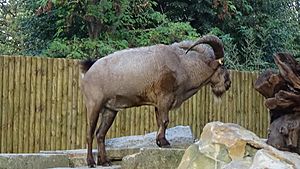West Caucasian tur facts for kids
Quick facts for kids West Caucasian tur |
|
|---|---|
 |
|
| Conservation status | |
| Scientific classification |
The West Caucasian tur (Capra caucasica) is a special type of goat-antelope. It lives only in the western part of the Caucasus Mountains. These amazing animals are found high up in the mountains.
Contents
About the West Caucasian Tur
The West Caucasian tur is a wild goat. It is known for its strong build and impressive horns. These animals are very good at climbing. They can move easily on steep, rocky slopes. This helps them find food and escape from predators.
What They Look Like
Male turs are usually larger than females. They can weigh up to 220 pounds (100 kg). Their fur is a reddish-brown color in summer. It turns to a duller brown in winter. This helps them blend in with their surroundings. Both males and females have horns. The male's horns are much bigger. They are thick and curve backward in a spiral shape. They can grow up to 30 inches (76 cm) long.
Where They Live
West Caucasian turs live in the high mountains. Their home is between 2,600 and 13,000 feet (800 and 4,000 meters) above sea level. They prefer rocky areas with forests below. In summer, they move to higher pastures. In winter, they come down to lower areas. This is where they can find more food. They are found only in the western Caucasus Mountains. This mountain range is located between the Black Sea and the Caspian Sea.
What They Eat
Turs are herbivores. This means they eat plants. Their diet changes with the seasons. In summer, they eat grasses, leaves, and young shoots. In winter, they might eat dry grass, moss, and lichen. They are very good at finding food in tough mountain environments.
Their Life Cycle
West Caucasian turs usually live in herds. Females and young turs live in smaller groups. Males often live alone or in bachelor groups. During the breeding season, called the rut, males will fight for females. This usually happens in November or December.
Reproduction and Young
After a pregnancy of about 5 to 6 months, a female tur gives birth. This usually happens in May or June. She typically has one kid. The young tur is able to stand and follow its mother soon after birth. This is very important for survival in the mountains. The mother protects her young carefully. The kids grow quickly and learn to climb from a young age.
Why They Are Special
The West Caucasian tur is unique. It is one of only three types of tur. The other two are the East Caucasian tur and the Dagestan tur. These animals are specially adapted to mountain life. Their hooves have soft pads inside. This gives them amazing grip on rocks. Their strong legs help them jump and climb.
Protecting Them
Sadly, the West Caucasian tur is an endangered species. This means their numbers are very low. They are listed as "Endangered" by the International Union for Conservation of Nature (IUCN). Their biggest threats are hunting and habitat loss. Their mountain homes are being affected by human activities.
Conservation Efforts
Many people are working to protect these animals. Laws have been made to stop illegal hunting. Some areas have become protected parks or reserves. The Caucasus Biosphere Reserve is one such place. These efforts help the turs survive. Protecting their habitat is key to their future. It is important for everyone to understand why these animals need our help.
Images for kids
See also
 In Spanish: Tur del Cáucaso occidental para niños
In Spanish: Tur del Cáucaso occidental para niños



